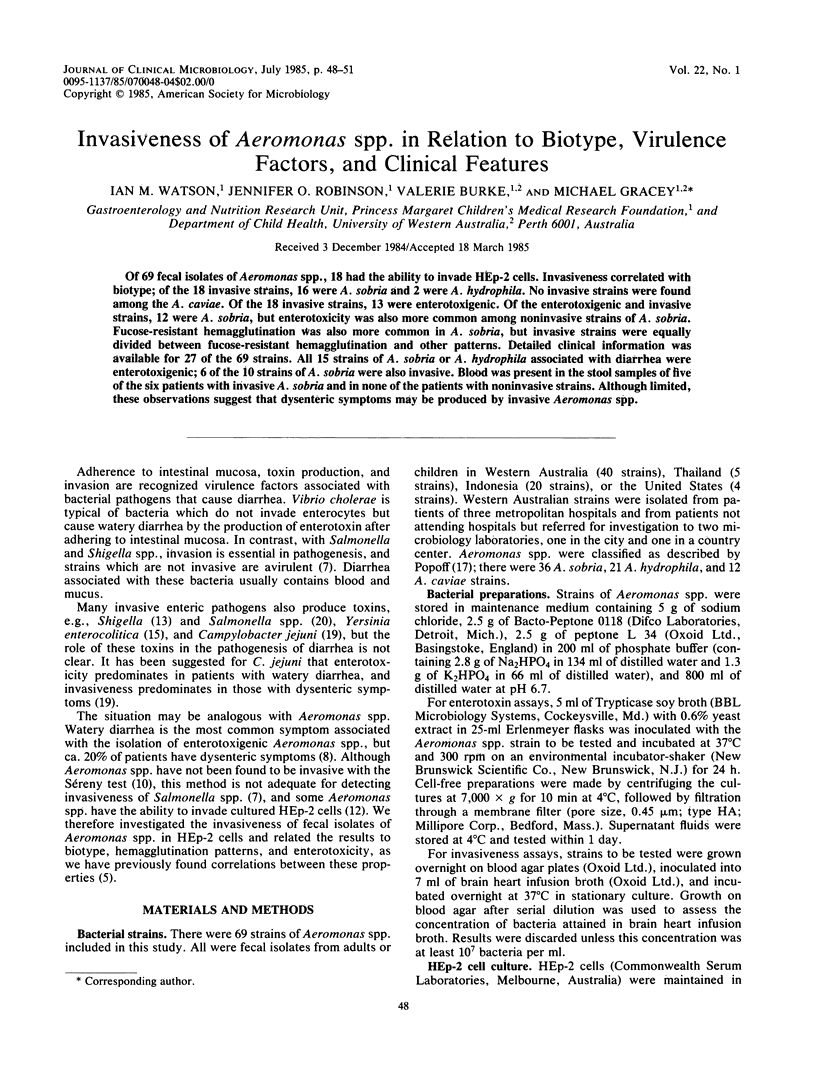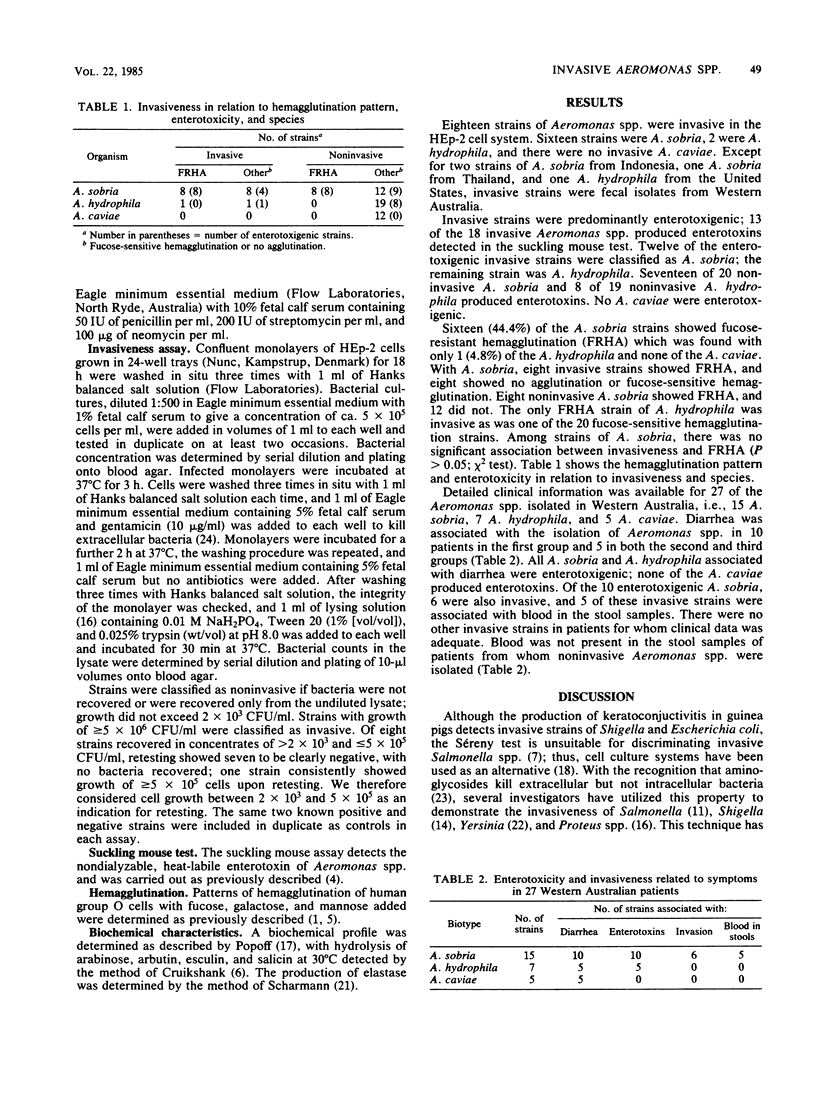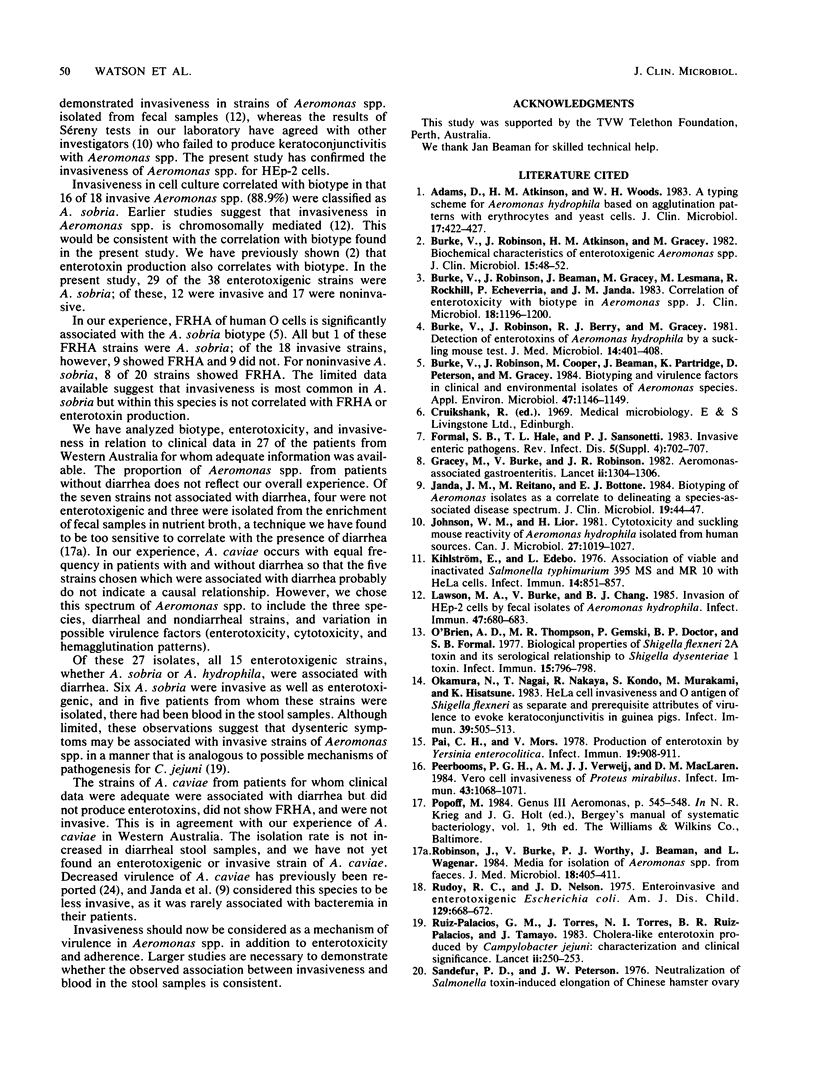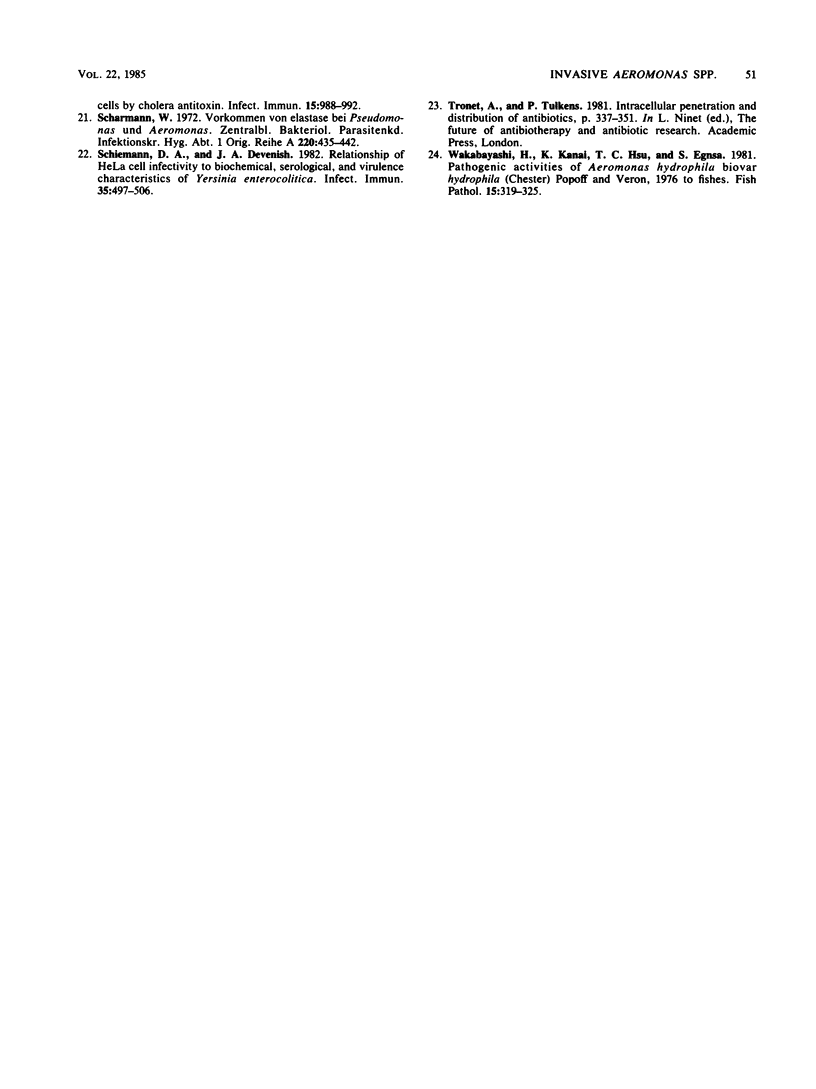Abstract
Of 69 fecal isolates of Aeromonas spp., 18 had the ability to invade HEp-2 cells. Invasiveness correlated with biotype; of the 18 invasive strains, 16 were A. sobria and 2 were A. hydrophila. No invasive strains were found among the A. caviae. Of the 18 invasive strains, 13 were enterotoxigenic. Of the enterotoxigenic and invasive strains, 12 were A. sobria, but enterotoxicity was also more common among noninvasive strains of A. sobria. Fucose-resistant hemagglutination was also more common in A. sobria, but invasive strains were equally divided between fucose-resistant hemagglutination and other patterns. Detailed clinical information was available for 27 of the 69 strains. All 15 strains of A. sobria or A. hydrophila associated with diarrhea were enterotoxigenic; 6 of the 10 strains of A. sobria were also invasive. Blood was present in the stool samples of five of the six patients with invasive A. sobria and in none of the patients with noninvasive strains. Although limited, these observations suggest that dysenteric symptoms may be produced by invasive Aeromonas spp.
Full text
PDF



Selected References
These references are in PubMed. This may not be the complete list of references from this article.
- Adams D., Atkinson H. M., Woods W. H. Aeromonas hydrophila typing scheme based on patterns of agglutination with erythrocytes and yeast cells. J Clin Microbiol. 1983 Mar;17(3):422–427. doi: 10.1128/jcm.17.3.422-427.1983. [DOI] [PMC free article] [PubMed] [Google Scholar]
- Burke V., Robinson J., Atkinson H. M., Gracey M. Biochemical characteristics of enterotoxigenic Aeromonas spp. J Clin Microbiol. 1982 Jan;15(1):48–52. doi: 10.1128/jcm.15.1.48-52.1982. [DOI] [PMC free article] [PubMed] [Google Scholar]
- Burke V., Robinson J., Beaman J., Gracey M., Lesmana M., Rockhill R., Echeverria P., Janda J. M. Correlation of enterotoxicity with biotype in Aeromonas spp. J Clin Microbiol. 1983 Nov;18(5):1196–1200. doi: 10.1128/jcm.18.5.1196-1200.1983. [DOI] [PMC free article] [PubMed] [Google Scholar]
- Burke V., Robinson J., Berry R. J., Gracey M. Detection of enterotoxins of Aeromonas hydrophila by a suckling-mouse test. J Med Microbiol. 1981 Nov;14(4):401–408. doi: 10.1099/00222615-14-4-401. [DOI] [PubMed] [Google Scholar]
- Burke V., Robinson J., Cooper M., Beaman J., Partridge K., Peterson D., Gracey M. Biotyping and virulence factors in clinical and environmental isolates of Aeromonas species. Appl Environ Microbiol. 1984 May;47(5):1146–1149. doi: 10.1128/aem.47.5.1146-1149.1984. [DOI] [PMC free article] [PubMed] [Google Scholar]
- Gracey M., Burke V., Robinson J. Aeromonas-associated gastroenteritis. Lancet. 1982 Dec 11;2(8311):1304–1306. doi: 10.1016/s0140-6736(82)91510-0. [DOI] [PubMed] [Google Scholar]
- Janda J. M., Reitano M., Bottone E. J. Biotyping of Aeromonas isolates as a correlate to delineating a species-associated disease spectrum. J Clin Microbiol. 1984 Jan;19(1):44–47. doi: 10.1128/jcm.19.1.44-47.1984. [DOI] [PMC free article] [PubMed] [Google Scholar]
- Johnson W. M., Lior H. Cytotoxicity and suckling mouse reactivity of Aeromonas hydrophila isolated from human sources. Can J Microbiol. 1981 Oct;27(10):1019–1027. doi: 10.1139/m81-159. [DOI] [PubMed] [Google Scholar]
- Kihlström E., Edebo L. Association of viable and inactivated Salmonella typhimurium 395 MS and MR 10 with HeLa cells. Infect Immun. 1976 Oct;14(4):851–857. doi: 10.1128/iai.14.4.851-857.1976. [DOI] [PMC free article] [PubMed] [Google Scholar]
- Lawson M. A., Burke V., Chang B. J. Invasion of HEp-2 cells by fecal isolates of Aeromonas hydrophila. Infect Immun. 1985 Mar;47(3):680–683. doi: 10.1128/iai.47.3.680-683.1985. [DOI] [PMC free article] [PubMed] [Google Scholar]
- O'Brien A. D., Thompson M. R., Gemski P., Doctor B. P., Formal S. B. Biological properties of Shigella flexneri 2A toxin and its serological relationship to Shigella dysenteriae 1 toxin. Infect Immun. 1977 Mar;15(3):796–798. doi: 10.1128/iai.15.3.796-798.1977. [DOI] [PMC free article] [PubMed] [Google Scholar]
- Okamura N., Nagai T., Nakaya R., Kondo S., Murakami M., Hisatsune K. HeLa cell invasiveness and O antigen of Shigella flexneri as separate and prerequisite attributes of virulence to evoke keratoconjunctivitis in guinea pigs. Infect Immun. 1983 Feb;39(2):505–513. doi: 10.1128/iai.39.2.505-513.1983. [DOI] [PMC free article] [PubMed] [Google Scholar]
- Pai C. H., Mors V. Production of enterotoxin by Yersinia enterocolitica. Infect Immun. 1978 Mar;19(3):908–911. doi: 10.1128/iai.19.3.908-911.1978. [DOI] [PMC free article] [PubMed] [Google Scholar]
- Peerbooms P. G., Verweij A. M., MacLaren D. M. Vero cell invasiveness of Proteus mirabilis. Infect Immun. 1984 Mar;43(3):1068–1071. doi: 10.1128/iai.43.3.1068-1071.1984. [DOI] [PMC free article] [PubMed] [Google Scholar]
- Robinson J., Burke V., Worthy P. J., Beaman J., Wagener L. Media for isolation of Aeromonas spp. from faeces. J Med Microbiol. 1984 Dec;18(3):405–411. doi: 10.1099/00222615-18-3-405. [DOI] [PubMed] [Google Scholar]
- Rudoy R. C. Enteroinvasive and enterotoxigenic Escherichia coli. Occurrence in acute diarrhea of infants and children. Am J Dis Child. 1975 Jun;129(6):668–672. doi: 10.1001/archpedi.1975.02120430008004. [DOI] [PubMed] [Google Scholar]
- Ruiz-Palacios G. M., Torres J., Torres N. I., Escamilla E., Ruiz-Palacios B. R., Tamayo J. Cholera-like enterotoxin produced by Campylobacter jejuni. Characterisation and clinical significance. Lancet. 1983 Jul 30;2(8344):250–253. doi: 10.1016/s0140-6736(83)90234-9. [DOI] [PubMed] [Google Scholar]
- Sandefur P. D., Peterson J. W. Neutralization of Salmonella toxin-induced elongation of Chinese hamster ovary cells by cholera antitoxin. Infect Immun. 1977 Mar;15(3):988–992. doi: 10.1128/iai.15.3.988-992.1977. [DOI] [PMC free article] [PubMed] [Google Scholar]
- Scharmann W. Vorkommen von Elastase bei Pseudomonas und Aeromonas. Zentralbl Bakteriol Orig A. 1972 May;220(1):435–442. [PubMed] [Google Scholar]
- Schiemann D. A., Devenish J. A. Relationship of HeLa cell infectivity to biochemical, serological, and virulence characteristics of Yersinia enterocolitica. Infect Immun. 1982 Feb;35(2):497–506. doi: 10.1128/iai.35.2.497-506.1982. [DOI] [PMC free article] [PubMed] [Google Scholar]


